Abstract
Ishibashi, Masahide (Osaka University, Osaka, Japan), Yoshinobu Sugino, and Yukinori Hirota. Chromosomal location of thymine and arginine genes in Escherichia coli and an F′ incorporating them. J. Bacteriol. 87:554–561. 1964.—The gene responsible for thymine requirement or independence in Escherichia coli K-12 is located on the chromosome, near Arg2 (arginine) and between Sm (streptomycin) and Ade (adenine). A new F′ (called F15) carrying the Thy (thymine) gene as well as the Arg2 gene was discovered. The Thy+ (thymine independent) gene on F15 relieves the defect of all Thy− (thymine requiring) mutants of E. coli examined, such as E. coli 15 T−, B3, and Thy− mutants obtained by aminopterine treatment. It can also be transferred to Thy− mutants of Salmonella typhimurium and Serratia marcescens, converting them to Thy+.
Full text
PDF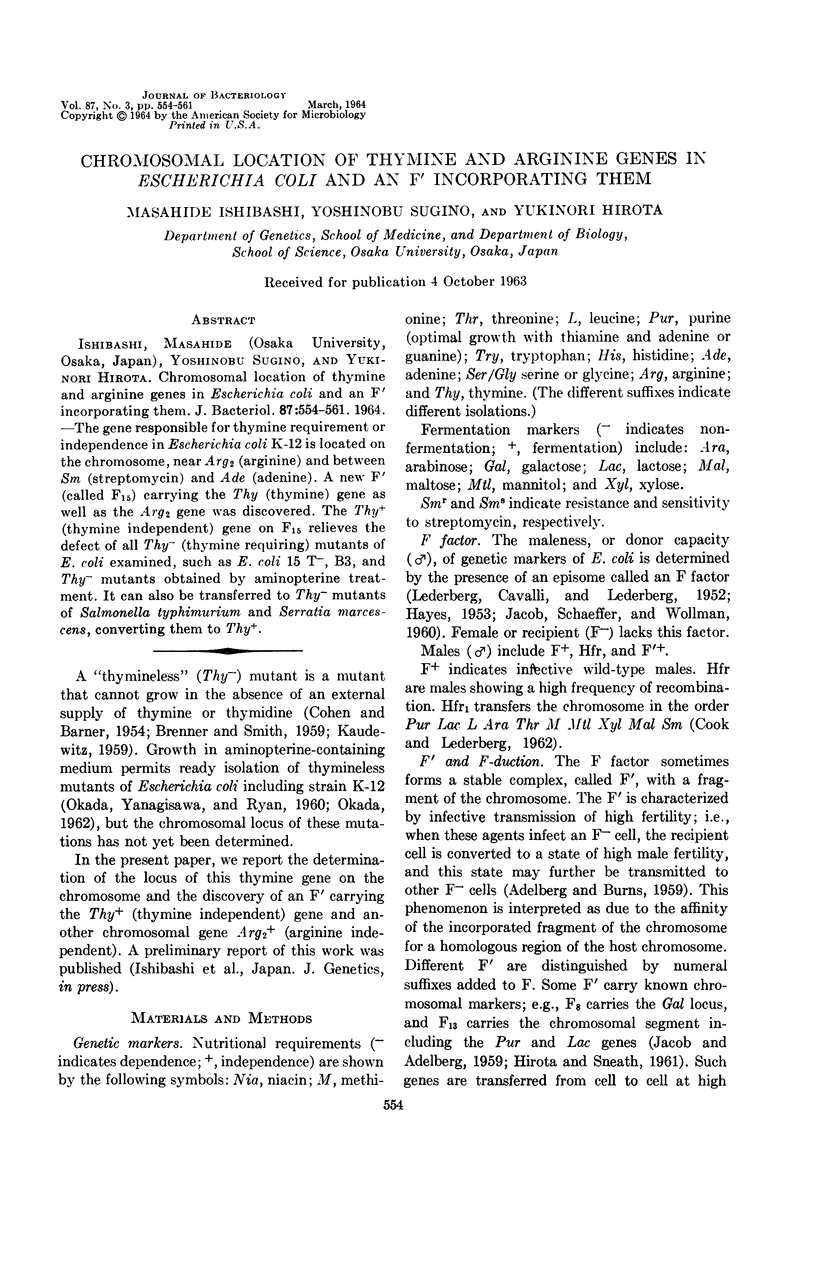

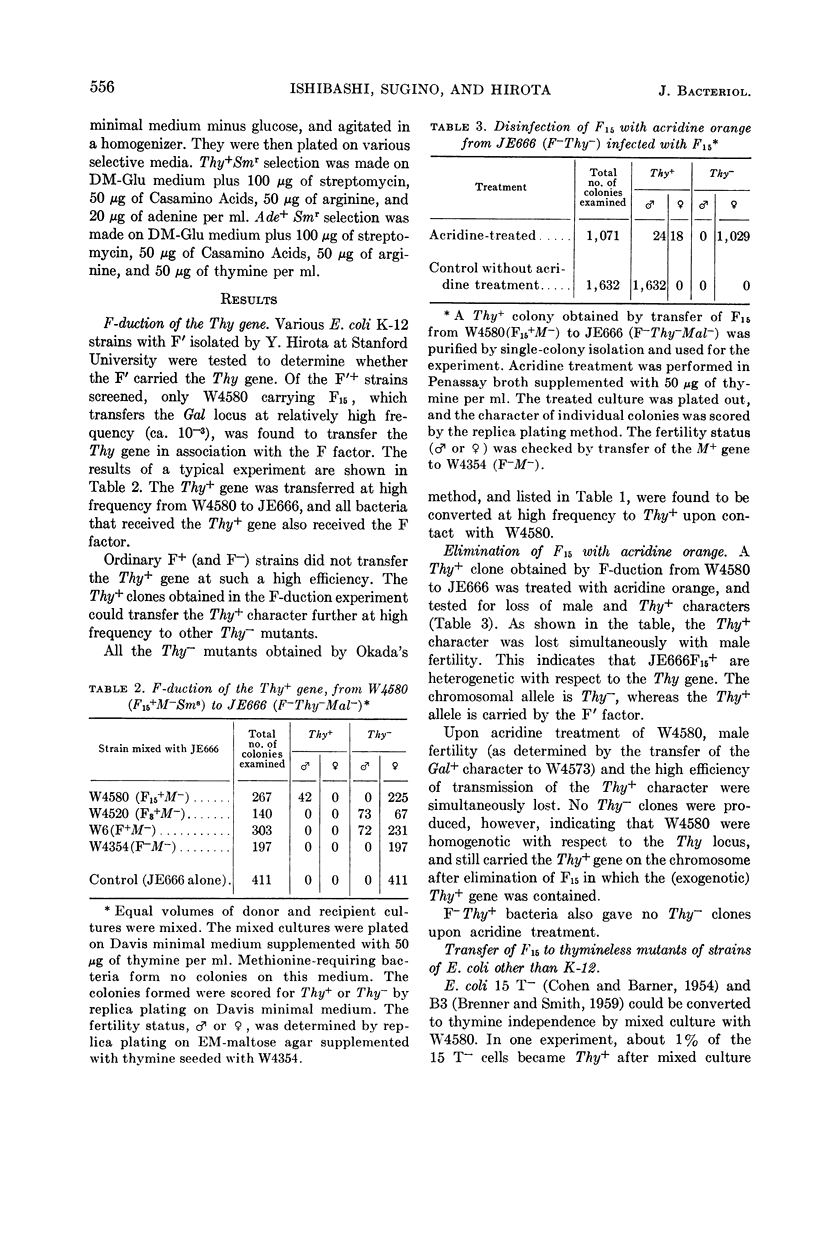
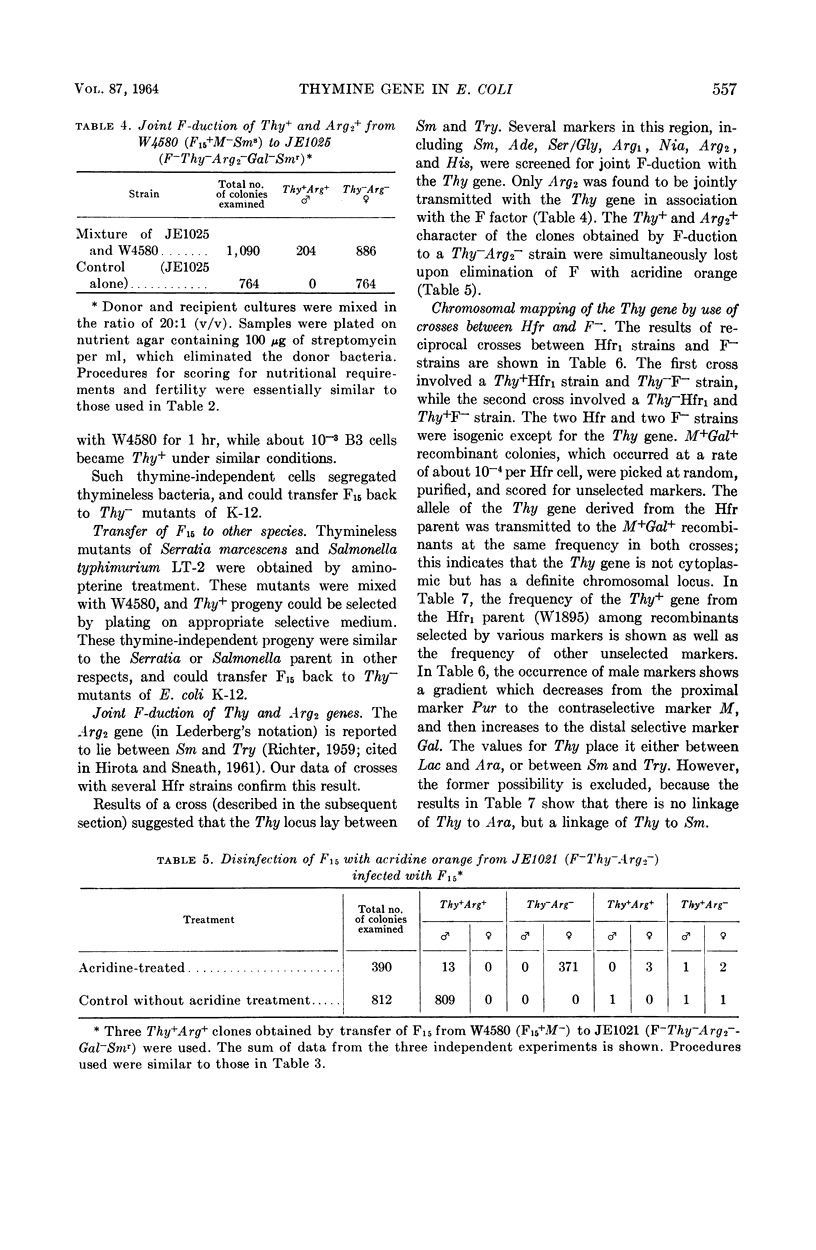


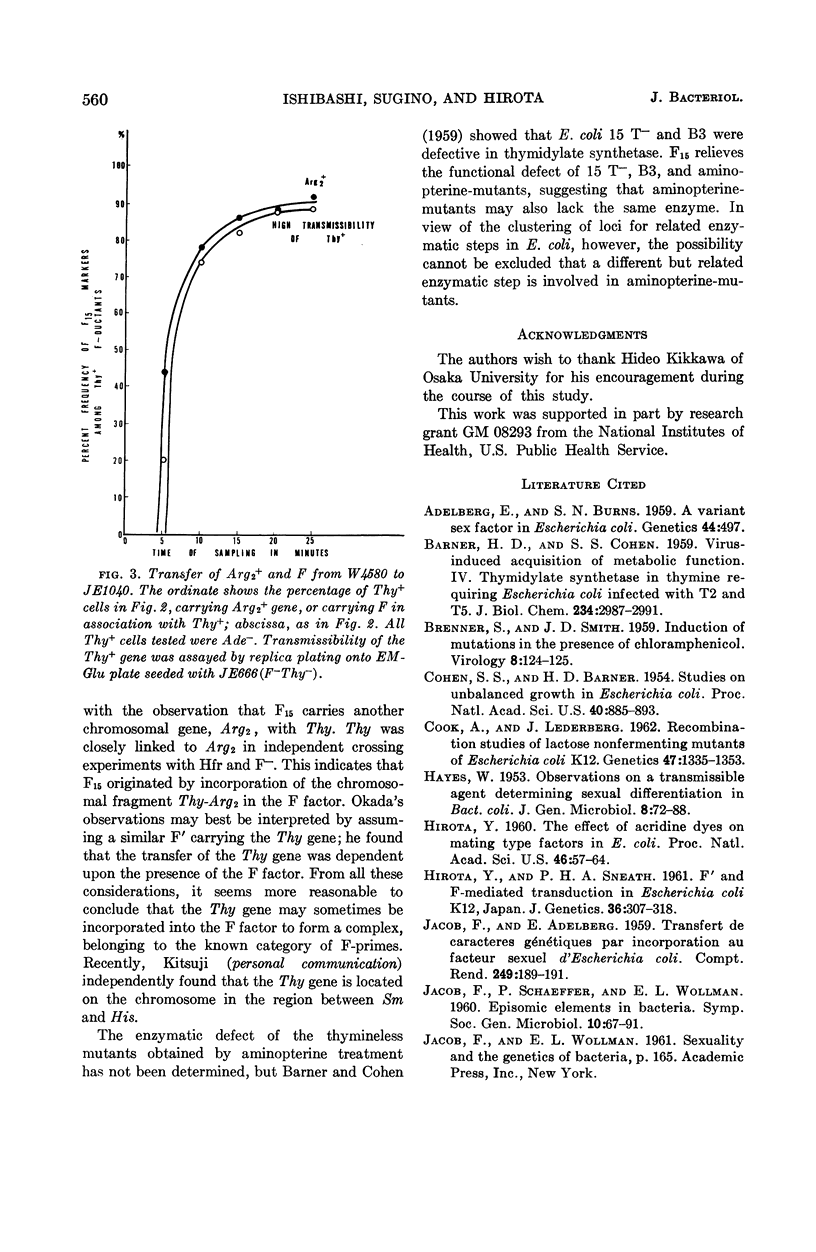
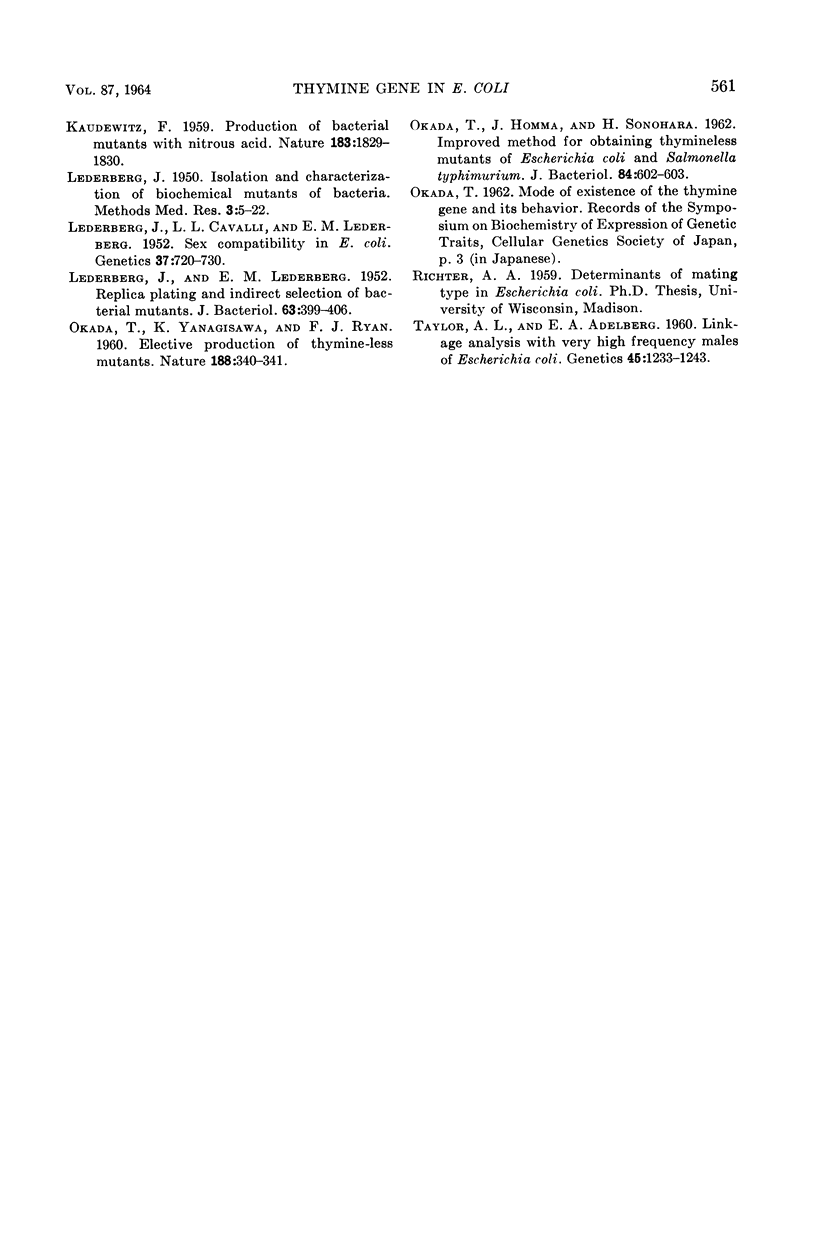
Selected References
These references are in PubMed. This may not be the complete list of references from this article.
- BARNER H. D., COHEN S. S. Virus-induced acquisition of metabolic function. IV. Thymidylate synthetase in thymine-requiring Escherichia coli infected by T2 and T5 bacteriophages. J Biol Chem. 1959 Nov;234:2987–2991. [PubMed] [Google Scholar]
- BRENNER S., SMITH J. D. Induction of mutations in the deoxyribonucleic acid of phage T2 synthesized in the presence of chloramphenicol. Virology. 1959 May;8(1):124–125. doi: 10.1016/0042-6822(59)90024-8. [DOI] [PubMed] [Google Scholar]
- COOK A., LEDERBERG J. Recombination studies of lactose nonfermenting mutants of Escherichia coli K-12. Genetics. 1962 Oct;47:1335–1353. doi: 10.1093/genetics/47.10.1335. [DOI] [PMC free article] [PubMed] [Google Scholar]
- Cohen S. S., Barner H. D. STUDIES ON UNBALANCED GROWTH IN ESCHERICHIA COLI. Proc Natl Acad Sci U S A. 1954 Oct;40(10):885–893. doi: 10.1073/pnas.40.10.885. [DOI] [PMC free article] [PubMed] [Google Scholar]
- HAYES W. [Observations on a transmissible agent determining sexual differentiation in Bacterium coli]. J Gen Microbiol. 1953 Feb;8(1):72–88. doi: 10.1099/00221287-8-1-72. [DOI] [PubMed] [Google Scholar]
- Hirota Y. THE EFFECT OF ACRIDINE DYES ON MATING TYPE FACTORS IN ESCHERICHIA COLI. Proc Natl Acad Sci U S A. 1960 Jan;46(1):57–64. doi: 10.1073/pnas.46.1.57. [DOI] [PMC free article] [PubMed] [Google Scholar]
- JACOB F., ADELBERG E. A. Transfert de caractéres génétiques par incorporation au facteur sexuel d'Escherichia coli. C R Hebd Seances Acad Sci. 1959 Jul 6;249(1):189–191. [PubMed] [Google Scholar]
- KAUDEWITZ F. Production of bacterial mutants with nitrous acid. Nature. 1959 Jun 27;183:1829–1830. doi: 10.1038/1831829a0. [DOI] [PubMed] [Google Scholar]
- LEDERBERG J., LEDERBERG E. M. Replica plating and indirect selection of bacterial mutants. J Bacteriol. 1952 Mar;63(3):399–406. doi: 10.1128/jb.63.3.399-406.1952. [DOI] [PMC free article] [PubMed] [Google Scholar]
- Lederberg J, Cavalli L L, Lederberg E M. Sex Compatibility in Escherichia Coli. Genetics. 1952 Nov;37(6):720–730. doi: 10.1093/genetics/37.6.720. [DOI] [PMC free article] [PubMed] [Google Scholar]
- OKADA T., HOMMA J., SONOHARA H. Improved method for obtaining thymineless mutants of Escherichia coli and Salmonella typhimurium. J Bacteriol. 1962 Sep;84:602–603. doi: 10.1128/jb.84.3.602-603.1962. [DOI] [PMC free article] [PubMed] [Google Scholar]
- OKADA T., YANAGISAWA K., RYAN F. J. Elective production of thymine-less mutants. Nature. 1960 Oct 22;188:340–341. doi: 10.1038/188340a0. [DOI] [PubMed] [Google Scholar]
- Taylor A L, Adelberg E A. Linkage Analysis with Very High Frequency Males of Escherichia Coli. Genetics. 1960 Sep;45(9):1233–1243. doi: 10.1093/genetics/45.9.1233. [DOI] [PMC free article] [PubMed] [Google Scholar]


